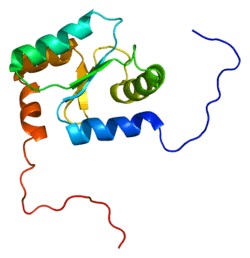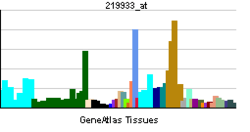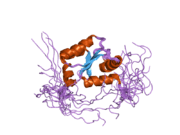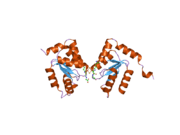GLRX2
| View/Edit Human | View/Edit Mouse |
Glutaredoxin 2 (GLRX2) is an enzyme that in humans encoded by the GLRX2 gene. GLRX2, also known as GRX2, is a glutaredoxin family protein and a thiol-disulfide oxidoreductase that maintains cellular thiol homeostasis. This gene consists of four exons and three introns, spanned 10 kilobase pairs, and localized to chromosome 1q31.2–31.3.[3]
Alternative splicing of GLRX2 leads to three isoforms of Grx2. One isoform, Grx2a, localizes to the mitochondria, is ubiquitously expressed in tissues (e.g. heart, skeletal muscle, kidney, and liver), regulates mitochondrial redox homeostasis, and protects cells against oxidative stress.[3] Isoforms Grx2b and Grx2c, both localized to the nucleus and cytosol, are expressed only in testes and cancer cell lines and facilitate cellular differentiation and transformation, potentially inducing tumor progression.[4][5][6]
Structure
Gene
The transcripts of mitochondrial and nuclear Grx2 isoforms, Grx2a and Grx2b, respectively, differ in the first exon, with the exon 1 in Grx2b located upstream of that in Grx2a.[5] Grx2c is derived from alternative splicing of the Grx2b transcript with a shorter exon 1 than that of Grx2b.[4]
Protein
As a GRX family protein, Grx2 has an N-terminal thioredoxin domain, possessing a 37CSYC40 active site motif with a serine residue replacing the conserved proline residue. This amino acid substitution allows the main chain of Grx2 to be more flexible, promoting coordination of the iron-sulfur cluster and facilitating deglutathionylation by enhanced glutathione-binding.[7] The cysteine pair (Cys28, Cys113) falls outside of the active site, and it is completely conserved in Grx2 proteins but not found in some other GRX family proteins (i.e. Grx1 and Grx5). A disulfide bond between this cysteine pair increases structural stability and provides resistance to over-oxidation induced enzymatic inactivation.[7]
Function
Grx2 functions as a part of the cellular redox signaling pathway and antioxidant defense mechanism. As a GRX family protein, Grx2 acts as an electron donor to deglutathionylate proteins. It has also been shown to reduce both thioredoxin 2 and thioredoxin 1 and protects cells from apoptosis induced by auranofin and 4-hydroxynonenal.[8] Grx2 is also an electron acceptor. It can catalyze the reversible oxidation and glutathionylation of mitochondrial membrane thiol proteins.[9] Additionally, NADPH and thioredoxin reductase efficiently reduce both the active site disulfide of Grx2 and the GSH-Grx2 intermediate formed in the reduction of glutathionylated substrates.[10]
Enzymatic activity of Grx2 leads to its role in regulating redox-induced apoptosis. Grx2 over-expression protects cells against H2O2-induced damage while Grx2 knockdown showed the opposite effect. The protection role of Grx2 against H2O2-induced apoptosis is likely associated with its ability to preserve the electron transport chain complex I.[11] In addition to H2O2, Grx2a overexpression is resistant to apoptosis induced by other oxidative stress reagents (i.e., doxorubicin (Dox) and phenylarsine oxide), due to reduced cardiolipin oxidation and subsequent cytochrome c release.[12] Interesting, Grx2 has also been found to prevent aggregation of mutant SOD1 in mitochondria and abolish its toxicity.[13]
Being a redox sensor, Grx2 activity is tightly regulated by the oxidative state of the environment via iron-sulfur cluster. In steady state, Grx2 forms dimers to coordinate iron-sulfur clusters, which in turn inactivate Grx2’s activity by sequestering the active-site cysteines. During oxidative stress, the dimers separate into iron-free active monomers, which restore Grx2’s activity.[7]
Clinical significance
From 42 cases of non-small cell lung cancer patients, the expression level of Grx2 showed a significant correlation with the degree of differentiation in adenocarcinoma and a clear inverse correlation with proliferation.[14] In tumor cells, cells with decreased Grx2 are dramatically sensitized to cell death induced by the anti-cancer drug, DOX.[15]
In cardiovascular disease, Grx2a overexpression protects mouse heart from Dox and ischemia-induced cardiac injury, potentially via increasing mitochondrial protein glutathionylation.[16] Conversely, Grx2 knockout hearts developed left ventricular hypertrophy and fibrosis, leading to hypertension. The mechanistic study shows that Grx2 knockout decreased mitochondrial ATP production, possibly via increased glutathionylation and thereby inhibition of complex I.[17]
Interactions
Grx2 has been shown to physically interact with MDH2, PITPNB, GPX4, CYCS, BAG3, and TXNRD1 in one independent high-throughput proteomic analysis.[18]
References
- ↑ "Human PubMed Reference:".
- ↑ "Mouse PubMed Reference:".
- 1 2 Gladyshev VN, Liu A, Novoselov SV, Krysan K, Sun QA, Kryukov VM, Kryukov GV, Lou MF (August 2001). "Identification and characterization of a new mammalian glutaredoxin (thioltransferase), Grx2". The Journal of Biological Chemistry. 276 (32): 30374–80. doi:10.1074/jbc.M100020200. PMID 11397793.
- 1 2 Lönn ME, Hudemann C, Berndt C, Cherkasov V, Capani F, Holmgren A, Lillig CH (March 2008). "Expression pattern of human glutaredoxin 2 isoforms: identification and characterization of two testis/cancer cell-specific isoforms". Antioxidants & Redox Signaling. 10 (3): 547–57. doi:10.1089/ars.2007.1821. PMID 18092940.
- 1 2 Lundberg M, Johansson C, Chandra J, Enoksson M, Jacobsson G, Ljung J, Johansson M, Holmgren A (July 2001). "Cloning and expression of a novel human glutaredoxin (Grx2) with mitochondrial and nuclear isoforms". The Journal of Biological Chemistry. 276 (28): 26269–75. doi:10.1074/jbc.M011605200. PMID 11297543.
- ↑ "GLRX2 glutaredoxin 2 [Homo sapiens (human)] - Gene - NCBI". www.ncbi.nlm.nih.gov. Retrieved 2016-07-21.
- 1 2 3 Johansson C, Kavanagh KL, Gileadi O, Oppermann U (February 2007). "Reversible sequestration of active site cysteines in a 2Fe-2S-bridged dimer provides a mechanism for glutaredoxin 2 regulation in human mitochondria". The Journal of Biological Chemistry. 282 (5): 3077–82. doi:10.1074/jbc.M608179200. PMID 17121859.
- ↑ Zhang H, Du Y, Zhang X, Lu J, Holmgren A (August 2014). "Glutaredoxin 2 reduces both thioredoxin 2 and thioredoxin 1 and protects cells from apoptosis induced by auranofin and 4-hydroxynonenal". Antioxidants & Redox Signaling. 21 (5): 669–81. doi:10.1089/ars.2013.5499. PMC 4098818
 . PMID 24295294.
. PMID 24295294. - ↑ Beer SM, Taylor ER, Brown SE, Dahm CC, Costa NJ, Runswick MJ, Murphy MP (November 2004). "Glutaredoxin 2 catalyzes the reversible oxidation and glutathionylation of mitochondrial membrane thiol proteins: implications for mitochondrial redox regulation and antioxidant DEFENSE". The Journal of Biological Chemistry. 279 (46): 47939–51. doi:10.1074/jbc.M408011200. PMID 15347644.
- ↑ Johansson C, Lillig CH, Holmgren A (February 2004). "Human mitochondrial glutaredoxin reduces S-glutathionylated proteins with high affinity accepting electrons from either glutathione or thioredoxin reductase". The Journal of Biological Chemistry. 279 (9): 7537–43. doi:10.1074/jbc.M312719200. PMID 14676218.
- ↑ Wu H, Xing K, Lou MF (October 2010). "Glutaredoxin 2 prevents H(2)O(2)-induced cell apoptosis by protecting complex I activity in the mitochondria". Biochimica et Biophysica Acta. 1797 (10): 1705–15. doi:10.1016/j.bbabio.2010.06.003. PMC 2964346
 . PMID 20547138.
. PMID 20547138. - ↑ Enoksson M, Fernandes AP, Prast S, Lillig CH, Holmgren A, Orrenius S (February 2005). "Overexpression of glutaredoxin 2 attenuates apoptosis by preventing cytochrome c release". Biochemical and Biophysical Research Communications. 327 (3): 774–9. doi:10.1016/j.bbrc.2004.12.067. PMID 15649413.
- ↑ Ferri A, Fiorenzo P, Nencini M, Cozzolino M, Pesaresi MG, Valle C, Sepe S, Moreno S, Carrì MT (November 2010). "Glutaredoxin 2 prevents aggregation of mutant SOD1 in mitochondria and abolishes its toxicity". Human Molecular Genetics. 19 (22): 4529–42. doi:10.1093/hmg/ddq383. PMC 3298854
 . PMID 20829229.
. PMID 20829229. - ↑ Fernandes AP, Capitanio A, Selenius M, Brodin O, Rundlöf AK, Björnstedt M (September 2009). "Expression profiles of thioredoxin family proteins in human lung cancer tissue: correlation with proliferation and differentiation". Histopathology. 55 (3): 313–20. doi:10.1111/j.1365-2559.2009.03381.x. PMID 19723146.
- ↑ Lillig CH, Lönn ME, Enoksson M, Fernandes AP, Holmgren A (September 2004). "Short interfering RNA-mediated silencing of glutaredoxin 2 increases the sensitivity of HeLa cells toward doxorubicin and phenylarsine oxide". Proceedings of the National Academy of Sciences of the United States of America. 101 (36): 13227–32. doi:10.1073/pnas.0401896101. PMC 516552
 . PMID 15328416.
. PMID 15328416. - ↑ Diotte NM, Xiong Y, Gao J, Chua BH, Ho YS (February 2009). "Attenuation of doxorubicin-induced cardiac injury by mitochondrial glutaredoxin 2". Biochimica et Biophysica Acta. 1793 (2): 427–38. doi:10.1016/j.bbamcr.2008.10.014. PMID 19038292.
- ↑ Mailloux RJ, Xuan JY, McBride S, Maharsy W, Thorn S, Holterman CE, Kennedy CR, Rippstein P, deKemp R, da Silva J, Nemer M, Lou M, Harper ME (May 2014). "Glutaredoxin-2 is required to control oxidative phosphorylation in cardiac muscle by mediating deglutathionylation reactions". The Journal of Biological Chemistry. 289 (21): 14812–28. doi:10.1074/jbc.M114.550574. PMC 4031535
 . PMID 24727547.
. PMID 24727547. - ↑ Tyers M. "GLRX2 (RP11-101E13.4) Result Summary". BioGRID. Retrieved 2016-07-21.
Further reading
- Davis DA, Newcomb FM, Starke DW, Ott DE, Mieyal JJ, Yarchoan R (October 1997). "Thioltransferase (glutaredoxin) is detected within HIV-1 and can regulate the activity of glutathionylated HIV-1 protease in vitro". The Journal of Biological Chemistry. 272 (41): 25935–40. doi:10.1074/jbc.272.41.25935. PMID 9325327.
- Lai CH, Chou CY, Ch'ang LY, Liu CS, Lin W (May 2000). "Identification of novel human genes evolutionarily conserved in Caenorhabditis elegans by comparative proteomics". Genome Research. 10 (5): 703–13. doi:10.1101/gr.10.5.703. PMC 310876
 . PMID 10810093.
. PMID 10810093. - Lundberg M, Fernandes AP, Kumar S, Holmgren A (July 2004). "Cellular and plasma levels of human glutaredoxin 1 and 2 detected by sensitive ELISA systems". Biochemical and Biophysical Research Communications. 319 (3): 801–9. doi:10.1016/j.bbrc.2004.04.199. PMID 15184054.
- Peltoniemi M, Kaarteenaho-Wiik R, Säily M, Sormunen R, Pääkkö P, Holmgren A, Soini Y, Kinnula VL (August 2004). "Expression of glutaredoxin is highly cell specific in human lung and is decreased by transforming growth factor-beta in vitro and in interstitial lung diseases in vivo". Human Pathology. 35 (8): 1000–7. doi:10.1016/j.humpath.2004.04.009. PMID 15297967.
- Lillig CH, Berndt C, Vergnolle O, Lönn ME, Hudemann C, Bill E, Holmgren A (June 2005). "Characterization of human glutaredoxin 2 as iron-sulfur protein: a possible role as redox sensor". Proceedings of the National Academy of Sciences of the United States of America. 102 (23): 8168–73. doi:10.1073/pnas.0500735102. PMC 1149418
 . PMID 15917333.
. PMID 15917333. - Fernando MR, Lechner JM, Löfgren S, Gladyshev VN, Lou MF (December 2006). "Mitochondrial thioltransferase (glutaredoxin 2) has GSH-dependent and thioredoxin reductase-dependent peroxidase activities in vitro and in lens epithelial cells". FASEB Journal. 20 (14): 2645–7. doi:10.1096/fj.06-5919fje. PMID 17065220.
- Berndt C, Hudemann C, Hanschmann EM, Axelsson R, Holmgren A, Lillig CH (January 2007). "How does iron-sulfur cluster coordination regulate the activity of human glutaredoxin 2?". Antioxidants & Redox Signaling. 9 (1): 151–7. doi:10.1089/ars.2007.9.151. PMID 17115894.
- Sagemark J, Elgán TH, Bürglin TR, Johansson C, Holmgren A, Berndt KD (September 2007). "Redox properties and evolution of human glutaredoxins". Proteins. 68 (4): 879–92. doi:10.1002/prot.21416. PMID 17546662.




